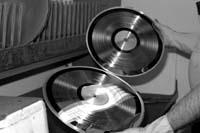Clap Hands Hear Comes Classic Records Jazz! Part 2

I went along on one such trip, sharing an 8 AM breakfast with Hobson and Ed Tobin, and arriving at RTI in the late afternoon. The same "warning" sign found at Greg Lee, is posted at RTI's front entrance- this time because of the polyvinyl chloride used in making records. Toxic stuff when its in a molten state. The pressing facility is located in a small industrial park. A furniture stripper across the way, a furntiture stripper isn't required to post any warning sign. Neither is a CD manufacturing plant I bet. Making records is a nasty business.
Inside RTI is a vinyl fetishist's wet dream. The automatic presses are clicking and clacking away, sandwiching the soft black pucks with labels, pressing them between the stampers and finally spitting out 180 gram "shaded dogs" which are stacked on a special platform where they await rice paper sleeves and jackets. Packed boxes of Classic LPs sit in another area. Jackets and sleeves sit elsewhere. Huge bins of virgin vinyl pellets are parked on the factory floor, vacuum hoses sucking the black gold into a special boiler where it turns molten. Ah! The smell of it!
Pressing mistakes litter a trashcan. When its full, the defective disks are put in a special machine which pops out the label area and pulverizes the rest for non virgin vinyl LPs- mostly alternative rock and dance. RTI doesn't recycle used vinyl, just defective pressings of its own virgin material. That's why vinyl from Sub Pop and the other labels using the facility still sound so good.
I pulled a few "shaded dog" popped biscuits from the garbage. "Hey! These'll make swell coasters! You could probably make more money selling these than the records!", sez I. And indeed everyone who's seen them wants a set of four. I don't think Hobson and Tan have taken my advice, so if you want a set, bug 'em.
The vibe at RTI is upbeat. There is pride on the faces of the workers who maintain the presses, package and box the discs, and finally sound them out for distribution and sale. From a business that seemed extinct a few years ago, RTI has grown to one that can barely keep up with demand today.
The old days of giant pressing plant factories, of tens of thousands of LPs pressed per stamper, of wafer thin, melted BIC pen vinyl are gone and good riddance to them and to the people who treated their records like so much disposable garbage. The record business will never be what it once was. Lets all applaud that! But let's not forget that only by buying the admittedly expensive, high quality custom pressed records now being offered by Classic and others, will we be assured of a continuing and growing supply of great music offered in the analogue domain.
Classic Critique
The trip to L.A. allowed me to watch the Classic Records guys in action. I received a real time education in the hassles and headaches involved in their enterprise. The hours spend at Bernie Grundman's listening to tapes, and cutting lacquers, the trips south to Greg Lee Processing, and north to RTI. The critical listening to test lacquers and test pressings. The cover art hassles-original album covers had to be procured, digitized and reproduced to a very high standard. The day-to-day headaches of advertising, bookkeeping and distribution.
Unfortunately, I missed what I consider to be the most interesting chapter in the story: namely how did these two guys get Jack Pfeifer and BMG, and Polygram to agree to let the tapes out the door? And to let them use the original artwork? Whose family jewels were mortgaged in the process? And how much did they have to pay for the reissue rights?
I asked Hobson and Tan these questions, but they really weren't interested in divulging too many details. After all, there are a zillion other great master tapes waiting for a vinyl rebirth. Why should they reveal their secrets now? And given the quality of the work, why should I attempt to learn and expose their methodology? So others, perhaps less committed to quality can horn in on the action?
When you look at the quality of the cover art, the almost perfect mastering and pressing, and ultimately the spectacular sound of most of these reissues, and the consistently good taste exercised in the choice of material to be reissued, the price you are asked to pay for these records is more than reasonable.
I left Los Angeles with only one criticism: November of 1994 after many of the RCAs had been reissued, and the Verves were being cut, Hobson and Tan had yet to assemble a high quality reference system on which to audition test cuts. Neither of the systems on which I heard test material was of reference or even near reference quality. That problem has been rectified: Classic has just moved to a new facility in Hollywood and set up a full range reference system in a dedicated listening room.
- Log in or register to post comments

















































